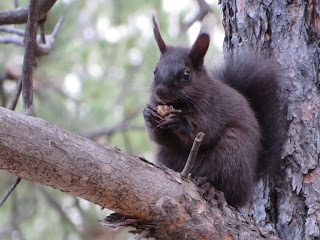This blog's
emphasis is on the two native tree squirrels you might encounter while hiking
through the Colorado forests: Abert’s and pine
squirrels.
 |
| (Abert's Squirrel) |
The
Abert’s squirrel (Sciurus aberti) is associated almost solely within
the montane (8,000-10,000 foot) forest ecosystem. They are quite distinct because of their
tufted, or tasseled, ears and black coat.
Interestingly, their ear tufts diminish in the spring and summer months,
while their fur color may range from the typical black, to gray.
Abert’s
squirrels make their home among mature ponderosa pine, using taste
to select trees with the most nutritional value. They rely on the ponderosa for all
aspects of their life including food, nesting, and cover. They are not known to
defend territories, perhaps because their home range is quite large, averaging nearly
20 acres.
Their
preferred food is the seeds of the ponderosa cone although their summer diet
contains a high proportion of fungi. You
might observe them holding the cone like an ear of corn, slowly rotating it as
they remove the cone scales to unveil the meaty seeds. Unlike many of their relatives, Abert’s
squirrels do not store large caches of food in their nest, although they occasionally
bury a cone.
 |
| (Pine Squirrel) |
The pine
squirrel, red squirrel, or chickaree (Tamiasciurus hudsonicus) is a solitary squirrel that is easily
identified as they scold intruders by growling, screeching, or chirping. These squirrels are much more aggressive than
the Abert’s squirrels and will jealously defend their territories. Their home range is restricted to mature
pine, Douglas-fir, fir, spruce, and mixed wood riparian forests. They generally
have multiple nests in tree hollows, or underground tunnels, and numerous food
caches.
The
pine squirrel is the smallest tree squirrel in Colorado with an average length
of 12 to 13 ½ inches. Its coloration is
rust red to grayish red, and its tail is outlined with a broad, black band
edged with white. Most of the squirrels
I’ve encountered in the Pikes Peak region tend towards the gray coloration.
 |
| (Pine Squirrel Midden) |
Generally,
pine squirrels have a favorite feeding tree where they eat and drop leftover cone
pieces. The shredded cones at the base of its feeding tree may accumulate into
huge piles, called middens, which may be 30 feet across and up to two feet
deep. Very large middens are evidence that several generations of squirrels
have used the same feeding tree. Territories
are usually centered around middens because they contain one to two years of
cone resources. Because of this, their
territory averages approximately two acres, depending on food availability.
 |
| (Ponderosa Pine tips sheared off) |
If
you have hiked in the montane ecosystem during the winter
months, you may have noticed needled tips littering the ground under select
ponderosa pines. This is the work of
both species as they feed on the shoots, slicing completely through the
branch. The mule deer enjoy this
delicacy and tend to clean up the mess left behind.

No comments:
Post a Comment